Looking for great educational activities for Valentine’s Day? Here are a few excellent ideas to use in your classroom in February!

Multiplication can be a daunting concept for some students. But in my many years as a teacher I have learned that starting out with a discovery activity can help students to understand the process of multiplication and relieve some of the stress.
I like to start off with a real world problem such as “Jessie has 4 plates of cookies. There are 5 cookies on each plate. How many cookies does she have in all?” I have students work in groups or with partners and with counters or color tiles to solve the problem concretely. I will walk around the room and discuss the methods used, and give a lot of praise for effort.
After working out the problem with the counters we will have a class discussion to recognize that there are many ways to solve the problem. Some students count, some skip count, some use repeated addition and some might already know a few multiplication tricks. I validate each method and move into the next phase, drawing pictures… Again I let students work in groups to find ways to draw pictures and then we share. After sharing I show the the way I like to make my pictures:
I continue this process with several more problems and then name multiplication as a way to solve problems with equal groups more quickly than adding.
We practice with picture problems as well and I reinforce vocabulary…
And, as with any skill, we practice, practice, practice!!!

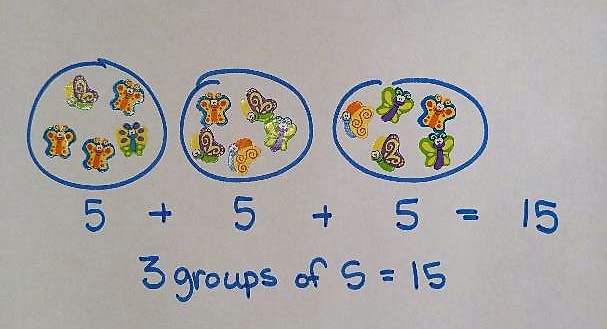
I would love to know what strategies you use to introduce multiplication in your classroom! Add them in the comment section below!
Some of my favorite memories of my elementary school years involve making crafts and playing games! My favorite craft was making gingerbread scented salt dough ornaments! But, anyone who teaches in this day and age knows we don’t always have time to do the fun stuff, right! So, to make the most of the season I sneak in a little holiday cheer as often as possible! Here are a few of my favorite ways to sneak in some fun when you have too much curriculum to cover or a dreaded math assessment to review for!
As simple as it sounds, white printer paper, colored markers and stickers or stamps can add a little holiday cheer to even the most dull math tasks! Here is an example of a Math Review I did yesterday with one of my Fourth graders. She has a test this week so we needed to spend some serious time reviewing fractions, but you can see that we still made it fun!
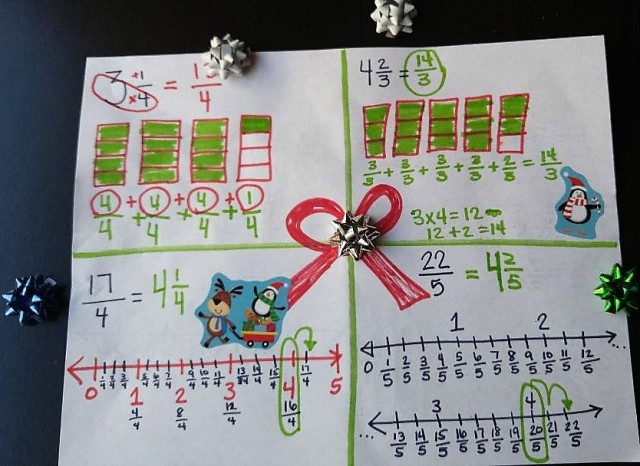
I bet you can figure out what my third graders are reviewing this week! Check out this simple array activity to practice multiplication! This could also be used for fact families!
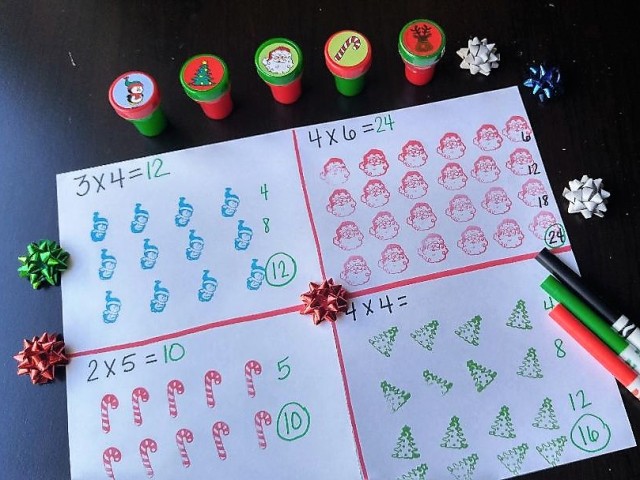
But what if you have to work on a review with word problems? No problem! You make that into a present too! Take any review or set of task cards and have students make a cheerful answer sheet like this:
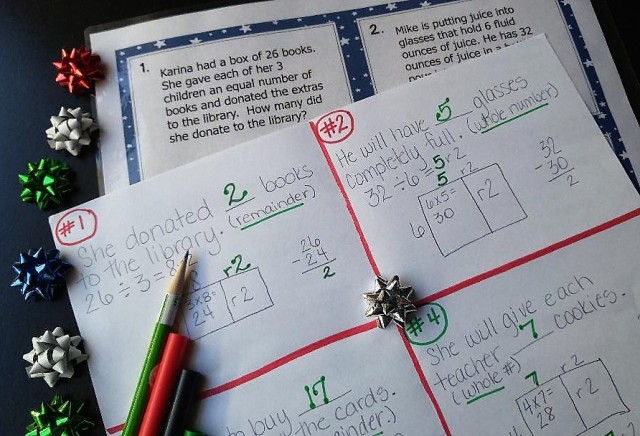
Well, if you know me at all, you know I LOVE MATH GAMES, so I will have to mention that you can turn any math skill into a game! Here is one of my favorites from my TpT Store:
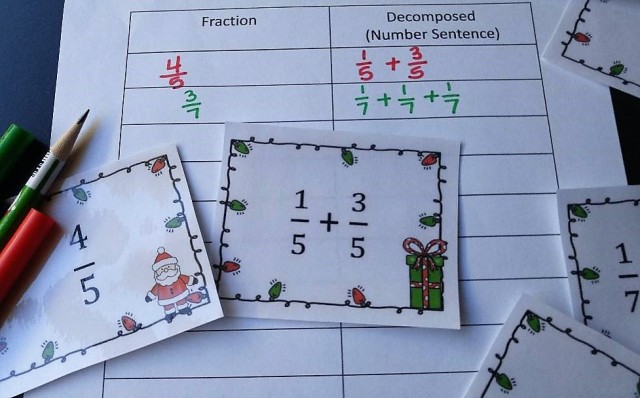
I would love to hear some other ideas people have for adding a little holiday fun to math class! Leave a comment below with your favorite activity!
‘Tis the season to be jolly … but, if we are in school we still have math skills to teach and review! Here are some awesome Holiday Math Craftivities and Activities to help your students have fun while still learning!
Have your students measure and cut strips of paper in specific lengths and use the strips to make Christmas Trees! This can be as simple as 1 inch, 2 inch, 3 inch or as complicated as area and perimeter or fractions depending on your students’ age/grade level.
How about fraction snowmen or “symmetries”? Cute, fun and educational!
This stacking cup game is designed for addition facts, but it could really be modified for any math skill!
These math games are lots of fun too! They are low prep and easy to play!
For more great Holiday Math Ideas check out my pinterest board!

Joy, Sunshine, and Lollipops has excellent ideas on her blog for celebrating Holidays Around the World!
How about a Grinch Day? Falling Into First has great ideas on her blog for celebrating Grinch Day!
Get your students moving around the room with this Math Scavenger Hunt! Your students will love solving word problems with partners.
Looking for great Read A Louds for Christmas? The Printable Princess has a collection for you.
How cute is this writing activity “If Santa Was Stuck in My Chimney…”? Check out other related ideas on the blog, First Grade Wow
These Holiday Math Games are perfect for elementary classrooms!
This Gumdrop Math Challenge is a great way to get your students using critical thinking skills while having fun!
More Math??? Here are some great ideas!
If you are having a class party, check out these 15 Class Games from A Girl and A Glue Gun.
And, how about some crafts?
Want more great ideas? Check out my Pinterest Holiday Board:
 What in the world do you do with early finishers? This is a big question for teachers! I think it is important to teach your students to check their work when finished. Teaching students to improve their work when they think they are finished is a valuable lesson. But, after that, there are always going to be a handful of students who will finish their work sooner than the rest of the class. So, back to the question … What do you do? Sitting and waiting for the rest of the class to finish or doing busy work can be very boring and is not giving these students a chance to continue learning. Here are some of my favorite ideas for early finishers!
What in the world do you do with early finishers? This is a big question for teachers! I think it is important to teach your students to check their work when finished. Teaching students to improve their work when they think they are finished is a valuable lesson. But, after that, there are always going to be a handful of students who will finish their work sooner than the rest of the class. So, back to the question … What do you do? Sitting and waiting for the rest of the class to finish or doing busy work can be very boring and is not giving these students a chance to continue learning. Here are some of my favorite ideas for early finishers!
Set up a system for students so they can find out what to do without disrupting the class or asking you while you are helping other students. I love this display that can be set up at the front of the room. The signs can be switched out depending on what you want the students to do each day.
Make sure your students know your expectations so they are not off task or disruptive. This poster is a great example and it is free! You could also make an anchor chart.
Have a place to organize the materials and supplies the students need for the activities to minimize questions such as “where do I get paper for _____ …. ?”
Extension menus are great for independent work. I like this reading menu, but you could make a menu for any subject. For example, if you are working on place value you could have a menu with place value activities for students to choose from.
Bulletin boards such as Boggle or Noggle can be fun! You can change the numbers or letters out every week or two. You could even put some students in charge of updating the board and making the answer key!
Stem Bins are a great hands on activity. Lots of fun while building reasoning skills.
Partner games and centers are a way to let your students interact with others while practicing skills.
Computer games and websites can be great learning tools. Make sure you set procedures up for how to get online and which sites students will go. Here are some of my favorites!
For more great ideas check out my early finishers board on Pinterest!
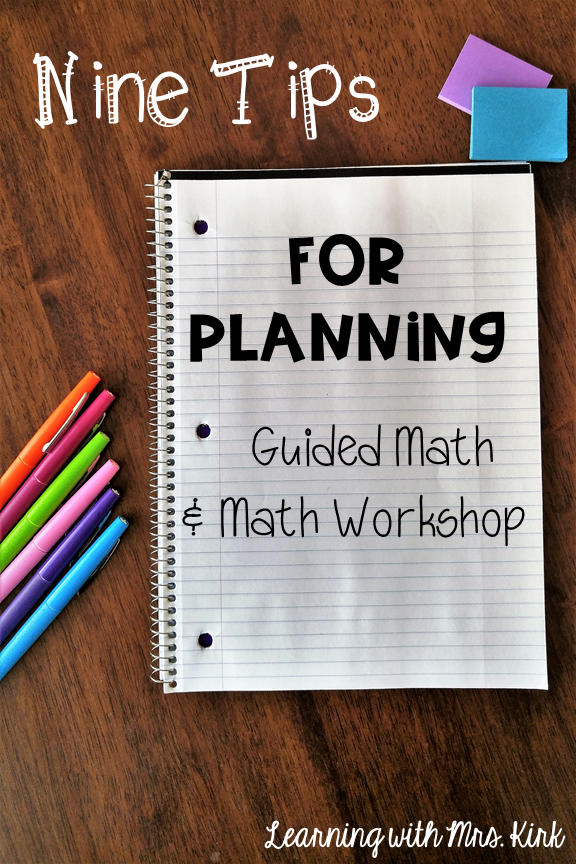

I am not sure when I learned how to write numbers in expanded notation, but I am certain it was not in 3rd grade. Students now are expected to learn how to write numbers in expanded notation as early as 3rd grade here in Texas and I am sure that applies to other states as well. But why? It is part of a push to help students understand the relationships between places and digits in our base ten number system. It can seem difficult at times, but with hands on activities and a lot of practice, your students can master expanded notation.
One method I find to be very effective is using play money:
Give your students a number. Guide them to use their play value money to model the number.

Then ask them “Ask “How many hundred thousands?” Tell “Expanded notation shows the number in each place times the value of the place, so 3 hundred thousands is 3 x 100,000.”

Continue questioning and guiding students to use play money to help them write the numbers.
You can download my play money for FREE by clicking the picture above.
For more great place value ideas, check out my Place Value Board on Pinterest!